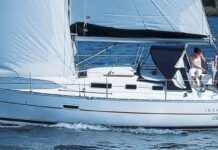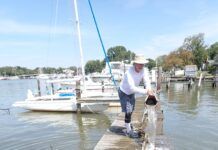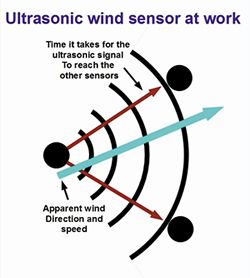
Youre standing on the sailboats bow on a windy day, facing the helm and yelling There is a rock ahead. Youre doing this while youre turning forward to look again. What the helmsman hears is There is a…..
Sound waves propagate through the air, and as you turned your mouth (the speaker) away from the direction of the helmsman, the wind blew those sound waves away. Ultrasonic wind sensors can measure this effect.
The distances between the sensors are close enough together that the sound waves arent blown away, and in windless conditions, the speed of sound is consistent and known. Each of the three sensors takes a turn at high frequency yelling while the other two listen.
The time it takes for each listener to hear the yelling is very accurately measured. Apply a lot of calculations, and you can derive both apparent wind direction and speed. As an example, if the wind is from aft of a transceiver, it will push the sound waves a little faster and they arrive earlier. Inversely, if the wind is blowing toward the transceiver, it slows down the sound waves, and it takes them longer to reach the other listeners. The difference in the time it takes to reach each listener is used to triangulate the direction the wind is traveling. This is a very simple explanation of a complex process.



































